
Without some rule, most games of go (weiqi in Chinese, baduk in Korean) would end in an infinite loop with each player capturing the stone his opponent had just played; see Figure 1. There is general agreement about most of the rules; but none of the proposed anti-loop rules has met universal acceptance.

"Ko" is the Japanese term for the repetition in Figure 1 and has come to denote any loop in play. The Japanese rules [1] outlaw the simple repetition of Figure 1, but if a more complex infinite loop occurs, the game is declared to have no result. (This is stronger than a draw: the players must start over.) Other ko rules try to prevent draws.
The "super-ko" rule, adopted by many associations, including the American Go Association [2], declares that repetition of the whole board pattern is not allowed. This rule seems reasonable in most practical cases, but has been criticized as being hard to administer and giving some "surprising" results.
The "SST" rules [3,5,6] avoid the putative difficulties of super-ko, but have been specified in language that is not always clear to an amateur go player. As specified, the rule requires players to recognize certain situations based on example diagrams in the rules.
This note presents two rules which cover the majority of the cases in the SST ko rules. The rules do not refer to patterns or concepts that are only apparent to experienced players. They do not even define the term "ko," although the usual ko rule for Figure 1 is a consequence. Experienced go players may wish to skim quickly through the first section below, which presents some background. The second section defines a few basic terms in preparation for the next two sections which define the basic rules. Subsequent sections compare them to the SST rules.
The rules themselves are in paragraphs preceded by a number and a right parenthesis. Various informal additions to the rules have an "A" in front of the number. These additions eliminate tedious plays necessitated by the other rules and bring the rules into alignment with SST.
More complex repetitive situations do occur and the introduction presented three approaches to resolving them. The Japanese rules simply void the game, the super-ko rule dictates non-repetition of the pattern of stones on the board, and the SST rules distinguish two kinds of kos.
Voiding the game as in the Japanese rules is a viable approach since complex repetitions are rare. However, in many amateur tournaments time is limited to something like a single weekend and there may be no good way to play the necessary extra game. Some observers also find the notion of a draw as contrary to the spirit of the simple ko rule of Figure 1.
Super-ko solves all problems of repetition, but is deemed by some experts to have two principal defects. First, it can be difficult to administer, especially by the sort of non-professional, volunteer referee found at most non-Asian tournaments. Detection of a board repetition is not too difficult, but it can be difficult to determine exactly which move began the repetition. For example, when two groups share three kos, the board exhibits six different patterns before it repeats. Even if the players have been keeping a record of the moves, determining which is the first illegal move can be daunting; if there is no record, resolution may try the talents of the best referee. Second, there arise a few obscure situations in which the super-ko rule can lead to results which some think are surprising. In Figure 2, for example, Black can capture one of the two one-eyed white groups, both of which some observers believe "ought" to be alive by virtue of having an eye while the enclosed black group does not. Black attacks first in the upper left group and then in the lower right. At the moment when the board is about to repeat the configuration in Figure 2, it is White's move, one of the white groups has only a single liberty, and an additional liberty can be gotten only by repeating the original board configuration. (Another supposedly surprising outcome is the possibility of life for the moonshine life group on the upper left in the diagram in section 5.4. This life depends on there being absolutely NO playable points on the board, so the situation is highly unlikely, at best.)

Reviewing the deficiencies of existing ko rules, Ing Chang-ki came to the conclusion that a new ko rule was required. After a decade of discussion he came up with the SST rule promulgated in English with document [3]. This rule divides ko battles into two classes, "fighting ko" and "disturbing ko." A fighting ko is one where winning the ko makes a difference to the life or death of a string (a string possibly just as small as the one stone that is being repeatedly captured, but possibly much bigger). In a disturbing ko battle, the safety of groups can be restored after one capture by another capture elsewhere. For these latter situations peaceful coexistence is possible and there is no need for a fight. One simple example of a disturbing ko battle, Figure 3, has two groups sharing four kos.

Classifying kos as either "fighting" or "disturbing" has not met universal enthusiasm. It is undeniably less simple to describe than the super-ko rule and many amateur players are not convinced that the defects of super-ko are sufficiently serious to warrant its abandonment. The defects arise so seldom that there is little experience with problems. It must be noted however, that these defects will become immediately noticed whenever they first affect the outcome of a tournament with a large prize at stake; this has caused crisis in earlier times and led to the first written form of the Japanese rules.
The description of the SST rules also deters its acceptance. Westerners, the most vocal critics, are accustomed to rules expressed as decision procedures in terms of simple concepts that do not require deep understanding of the game. The super-ko rule is such a decision procedure: we need only remember board patterns and detect repetition; there is no need to understand the game at all. The SST rule, however, is stated in terms of situations that can be recognized only by understanding the game and recognizing patterns. The concepts used in the rules include poorly defined terms; for instance "invariation," which may mean the super-ko rule or may mean something slightly different. The word "ko" is used somewhat ambiguously and may refer to a portion of a game diagram, a set of adjacent strings, or even the whole board diagram if it includes a ko. At the very heart of the rules is the distinction between fighting and disturbing kos, which is said to depend on whether "life and death are decided," even though deciding life and death is difficult and the rules elsewhere state that life and death are to be decided only by the play of the stones. Attempts to write a computer program to implement the SST rules as stated have not yet succeeded, from which it would seem that they are not specified clearly or precisely enough.
Despite the above comments, no one has brought forth a game diagram
which convincingly demonstrates that SST's distinction between fighting
and disturbing ko is indeterminate. Nor has anyone really shown that
the SST rule is as hard to administer as the super-ko rule admittedly
is. With this in mind, I believe it is appropriate to try to more
precisely define the SST ko rule, or at least something close. That
way further discussion can be based on fact rather than conjecture.
2) Adjacent. Two points are adjacent if an arc connects them. Two stones are adjacent if they occupy adjacent points. A stone is adjacent to an empty point if the stone occupies a point adjacent to that empty point.
3) String. A set of stones of a single color is a string if there is a sequence of adjacent like-colored stones from every stone of the set to every other and there is no such sequence to any like-colored stone not in the set.
4) Liberty. A liberty of a string is any empty point adjacent to a stone in that string. The liberty count of a string is its number of liberties.
5) Capture. A string is captured if it has only one liberty and the opponent places a stone on that liberty point. Captured stones are removed from the board, leaving their point empty.

7) Same capture. Two capture moves are the same if the capturing stones are played at identical board points and the set of stones captured by the first capture occupied the same board points as the stones captured by the second. {See Figure 5e.}
8) Cycle sets. If a capture is the same as a capture earlier in the game and both leave the same board configuration, all intersections at which stones were played by intervening moves are added to the cycle set for the capture. The cycle set for any capture that has not been repeated is empty.
9) Rule: Cycle sets. If a play makes a capture that has or creates a non-empty cycle set, the opponent's next move must not be at any board point in that set.






Figure 5 demonstrates that the Cycle Sets rule reduces to the ordinary ko rule. The sequence illustrated could be followed every time a ko arises, which would be pointless. To prevent this we need an informal rule:
Stones on points in the Cycle Set include those called "hot stones" in SST terminology, but also can include stones which we will later see can be part of disturbing kos. See Figure 6, which shows a cycle set larger than two points.
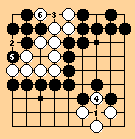
The cycle set rule requires that a remote disturbing situation like the upper left in Figure 6 be used as ko threats by both players in succession in order to add those two kos to the cycle set for the capture at 1. It might be nicer to accept the two ko threats at any time during the ko fight, but it is then not so easy to formulate the rule.
11) Threatened. A string is threatened if it has only one liberty. A move threatens a string if its reduces the string's liberties to one.
12) Potentially disallowed. A move is potentially disallowed if it is unconstrained, it threatens an opponent string, and does not increase the liberties of any threatened string of its own color.
13) Counteracted - A potentially disallowed move is counteracted by a subsequent opponent's move which does not capture the stone played as the potentially disallowed move, but does increase to two or more the liberties of the move's threatened strings.
14) Move signature - A move's signature is the set consisting of the board point at which the stone is played, the board points from which stones were captured, and the board points occupied by stones threatened by the move.
15) Rule: Disallowed capture. If a potentially disallowed move
is counteracted, then the player who made that move must never again
make an unconstrained move with the same signature.


Definition (10) for "constrained moves" is introduced so that moves used
as ko threats do not become potentially disallowed and moves already
disallowed are valid as ko threats. However, they will soon be entered
in a cycle set for the ko. For example, see Figure 6. The cycle from
1 to 7 restores the board to its original configuration and points
2, 3, 5, and 6 are added to the cycle set for 1. The upper left will
have been used exactly once as a ko threat by each player. In some
cases, one player will not respond to the ko threat, preferring to
fill the ko. This is fine; the other player is free to make good on
the ko threat.


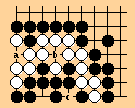
There are two ways White may try to kill black in this corner, both prevented by the rules above. First, White may try to capture b or c and claim that the Etiquette of Obvious Cycles (i.e., "hot stones") force Black to make a ko threat. This fails because White cannot satisfy the Etiquette by demonstrating that a cycle set will arise when Black captures the other of c or b. Instead, White's captures at b and c become disallowed (rule 15). Second, White may try to use b or c as a ko threat when Black tries to capture White by playing at a. This also fails because Black also uses b and c as ko threats, recreating a board configuration and entering b and c into the cycle set for White's capture of a (rule 9). When White has no ko threats, Black takes at a and then captures the white stones.

Black plays at 1, white captures, and black recaptures at x. The board is the same as an earlier board, but it is the other player's turn. This is legal under most rule sets, even including super-ko as defined by the AGA. A cycle set is created only in the unlikely event that a previous play at x captured a stone in the corner. However, even if there is no cycle set, White will be unlikely to play in this corner. No disallowed captures are created because liberty counts prior to the captures are one.

White may try to claim that the upper left group cannot be captured because when Black plays at 1, White makes a ko threat in the lower right. However, Black also uses the lower right for a ko threat, the board repeats, and the four ko points in the lower right are entered into the cycle set for the ko at 1 (rule 9). Thereafter white must make ko threats elsewhere, but black need never make threats, just as in SST. If requested to demonstrate capture, black plays on until white has no ko threats; black captures at 1 and white has no ko threats so white passes and black captures the group.
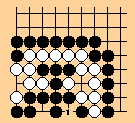
If White captures at 1, Black counteracts by capturing one of the other
kos and restoring the black string to two liberties. Thereafter, a
capture by White at 1 is disallowed (rule 15). Similarly all possible
ko captures here can become disallowed and the situation remains on
the board, just as in SST.

Both inner strings have two liberties. Under the Disallowed Capture rule (15), if either party captures one of these three kos, the opponent can capture another ko to return both strings to two liberties. Captures inside thus become disallowed. When the white string's external liberty is filled, the ko fight begins as in a usual triple ko.
Curiously, the external liberty may never be filled and the diagrammed
situation could remain on the board. Clearly, White will not fill
the external liberty; that would be suicidal. When Black fills the
external liberty, White captures a ko, forcing Black to make the first
ko threat. If Black's ko threats are too small relative to this situation,
Black will not fill the external liberty either. Leaving the liberty
unfilled is not a problem for the rules: both sets of stones stay
on the board for the scoring phase, giving Black two points and White
one.



The SST rules differ slightly. They also forbid the move at 3 following 2, but the other illegal move is the capture at 2 following the play at 1; the play at 4 following 3 is allowed. Even so, both Black and White have to make one ko threat per iteration. To match SST exactly, we would need to add:
Bill Spight (BillSpight@aol.com) has noted that after Black 3 White
could get a seki by playing 4 at 2, but that this move might be forbidden
by the Cycle Set rule. However, the cycle does not occur until 4 is
played, so playing 4 at the position of 2 is acceptable. Even on later
iterations White can play at 2 after black captures with 3. By a strict
reading of the rules Black 3 does not create a cycle set if White has
just made a ko threat, because the board configuration is different
(due to the stones played for the ko threat and response).


The SST rules [3] provide this explanation:
White 2 and Black 7 are game-disturbing moves that use ko threats cyclically. This must be prohibited.
This implies that White must make a ko threat before playing 2 and Black must do likewise before playing 7. The entire situation is deemed a ko fight by the SST rules (although neither player has ko threats in the diagram.)
The ko fight is much more direct with rules 9 and 15 above; White makes a ko threat in lieu of 2 and then recaptures 1. The analysis begins wth the reasonable assumption that White's move prior to Black 1 did not capture at Black 1 and therefore left the situation as shown on the left without the numbered stones and without an immediately preceding capture. The first iteration ends when White plays 10 and Black then plays 11 at 1 to initiate the second iteration, with White forced to make a ko threat according to rule 9. When Black responds to White's threat, White captures back with a play at 8, and a simple ko fight ensues.
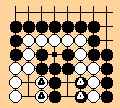
A four step sequence of moves can occur: each player plays a stone to reduce to one the liberties of a triangled string and the next two moves are captures, each capturing a triangled string. The first of these captures reduces an opponent string to a single liberty and is potentially disallowed. This move is immedaitely counteracted by the other capture, so the first capture becomes a disallowed move.
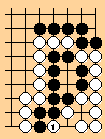
The disallowed captures rule (15) interrupts the cycle inherent in this diagram. When White plays on line 4 or 5, the black string is reduced to one liberty and the capture is counteracted when Black captures the stone marked 1. On the second cycle White will be able to make the other throwin, but on the third cycle White will have no move.
To resolve this difference, the rules can be augmented in several ways. My favorite candidate is:
One alternative to the TKO rule is to formulate a rule which specifies
that every ko must be filled once it has been captured and before any
other ko between the same groups can be captured. This scheme requires
that "ko" be defined, but may have the virtue of supplanting all the
other rules.
The aim here has been an approximate statement of the SST ko rule.
Proponents of the latter may now be able to more clearly explain it
by describing in detail how it differs from the rules above.
References
[1] The Nihon Kiin, The Kansai Kiin, The Japanese Rules of Go, The
Nihon Kiin, tr. James Davies, April 10, 1989.
[2] AGA Rules Committee, Official AGA Rules of Go, American Go Association, April 1, 1991.
[3] Ing - Ing Chang-ki, Ing's SST Laws of Wei-Chi, 1991, Trans. James Davies; Ing Chang-Ki Wei-Ch'i Educational Foundation; 4F, No. 35, Kuan Fu S. Rd.; Taipei, Taiwan, R.O.C.; Tel:886-2-7614117; Fax:886-2-7686940
[4] Jasiek, Robert, "Ing Ko Examples," http://www.inx.de/~jasiek/ingkoexa.html, July 7, 1996.
[5] Kim, Janice, Michael Simon, and Phil Straus "Ing's SST Rules of Go". Available from bsdserver.ucsf.edu/Go/aga/ or from AMERICAN GO ASSOCIATION; Box 397, Old Chelsea Station; NY, NY 10113; USA
[6] Yuan, Sidney, American Go Extra, Fall(?), 1995. Yutopian Enterprises; 4964 Adagio Ct; Fremont, CA 94538; USA Tel: +1 (510) 659-0138 (1-800)YUTOGO-3. email: yutopian@netcom.com (Originally distributed via internet newsgroup rec.games.go)
[7] Hall, T. Mark, A Problem of Status, British Go J., 94, Spring 1994, p. 29. Followup under the same title: Hazelden, Paul, British Go J., #95, Summer 1994, p. 31.